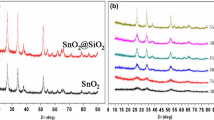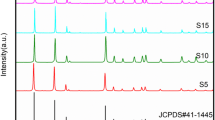Abstract
A method of electrochemical oxidation and dispersion of tin electrodes under alternating pulse current was proposed as a novel approach for the synthesis of SnO2 nanoparticles suitable as an alternative anode for lithium ion batteries. The electrochemically obtained, non-hydrated SnO2 nanopowder was crystalline, having a tetragonal lattice and an average crystallite size of about 11–16 nm. When used as anode in lithium ion batteries, the material delivered around 680 mAh g−1 reversible capacity with 66 % capacity retention over more than 60 cycles.
Graphical Abstract










Similar content being viewed by others
References
Park C-M, Kim J-H, Kim H, Sohn H-J (2010) Li-alloy based anode materials for Li secondary batteries. Chem Soc Rev 39:3115–3141
Wu HB, Chen JS, Hng HH, Lou XWD (2012) Nanostructured metal oxide-based materials as advanced anodes for lithium-ion batteries. Nanoscale 4:2526–2542
Hu R, Liu H, Zeng M, Liu J, Zhu M (2012) Progress on Sn-based thin-film anode materials for lithium-ion batteries. Chin Sci Bull 57:4119–4130
Idota Y, Kubota T, Matsufuji A, Maekawa Y, Miyasaka T (1997) Tin-based amorphous oxide: a high-capacity lithium-ion-storage material. Science 276:1395–1397
Chen JS, Lou XWD (2013) SnO2-based nanomaterials: synthesis and application in lithium-ion batteries. Small 9:1877–1893
Chen JS, Archer LA, Lou XWD (2011) SnO2 hollow structures and TiO2 nanosheets for lithium-ion batteries. J Mater Chem 21:9912–9924
Ding S, Luan D, Boey FYC, Chen JS, Lou XWD (2011) SnO2 nanosheets grown on graphene sheets with enhanced lithium storage properties. Chem Commun 47:7155–7157
Zhao K, Du G, Qin G, Liu Y, Zhao H (2015) Facile synthesis of boscage-like SnO2 nanorods by hydrothermal method. Mater Lett 141:351–354
Madzlan Aziz A, Abbas SS, Baharom WRW (2013) Size-controlled synthesis of SnO2 nanoparticles by sol-gel method. Mat Lett 91:31–34
Köse H, Aydin AO, Akbulut H (2013) Sol–gel preparation and electrochemical characterization of SnO2/MWCNTs anode materials for Li-ion batteries. Appl Surf Sci 275:160–167
Kamali AR, Fray DJ (2012) Solid phase growth of tin oxide nanostructures. Mater Sci Eng B 177:819–825
Zhang JB, Li XN, Bai SL, Luo RX, Chen AF, Lin Y (2012) High-yield synthesis of SnO2 nanobelts by water-assisted chemical vapour deposition for sensor applications. Mater Res Bull 47:3277–3282
Wang B, Yang YH, Wang CX, Xu NS, Yang GW (2005) Field emission and photoluminescence of SnO2 nanograss. J Appl Phys 98:124–303
Rajendran V, Anandan K (2012) Size, morphology and optical properties of SnO2 nanoparticles synthesized by facile surfactant-assisted solvothermal processing. Mater Sci Semicond Process 15:393–400
Chen D, Gao L (2004) Novel synthesis of well-dispersed crystalline SnO2 nanoparticles by water-in-oil microemulsion-assisted hydrothermal process. J Colloid Interface Sci 279:137–142
Petrii A (2015) Electrosynthesis of nanostructures and nanomaterials. Russ Chem Rev 84:159–193
Chen W, Ghosh D, Chen S (2008) Large-scale electrochemical synthesis of SnO2 nanoparticles. J Mater Sci 43:5291–5299
Korobochkin VV, Balmashnov MA, Gorlushko DA, Usoltseva NV, Bochkareva VV (2012) The phase composition of nanodispersed tin oxides obtained by alternating current electrochemical synthesis. Sib J Sci 1:45–51
Yanson AI, Rodriguez P, Garcia-Araez N, Mom RV, Tichelaar FD, Koper MTM (2011) Cathodic corrosion: a quick, clean, and versatile method for the synthesis of metallic nanoparticles. Angew Chem Int Ed 50:6346–6350
Kabanov BN, Astakhov II, Kiseleva IG (1965) Electrochemical implantation of alkali metals. Russ Chem, Rev 34(10):775–785
Kabanov BN (1968) Incorporation of alkali metals into solid cathodes. Electrochim Acta 13:19–25
Leontyev I, Kuriganova A, Kudryavtsev Yu, Dkhil B, Smirnova N (2012) New life of a forgotten method: electrochemical route toward highly efficient Pt/C catalysts for low-temperature fuel cells. Appl Catal A 431:120–125
Smirnova NV, Kuriganova AB, Leontyeva DV, Leontyev IN, Mikheikin AS (2013) Structural and electrocatalytic properties of Pt/C and Pt-Ni/C catalysts prepared by electrochemical dispersion. Kinet Catal 54:255–262
Leontyeva DV, Leontyev IN, Avramenko MV, Yuzyuk YuI, Kukushkina YuA, Smirnova NV (2013) Electrochemical dispersion as a simple and effective technique toward preparation of NiO based nanocomposite for supercapacitor application. Electrochim Acta 114:356–362
Díaz R, Díez-Pérez I, Gorostiza P, Sanz F, Morante JR (2003) An electrochemical study of tin oxide thin film in borate buffer solutions. J Braz Chem Soc 14:523–529
Morgan Tench D, Anderson DP, Kim P (1994) Solderability assessment via sequential electrochemical reduction analysis. J Appl Electrochem 24:18–29
Cho S, Yu J, Kang SK, Shin D-Y (2005) Oxidation study of pure tin and its alloys via electrochemical reduction analysis. J Electron Mater 34:635–642
Alvarez PE, Ribotta SB, Folquer ME, Gervasi CA, Vilche JR (2002) Potentiodynamic behaviour of tin in different buffer solutions. Corros Sci 44:49–65
Nathira Begum S, Basha A, Muralidharan VS, Lee CW (2012) Electrochemical behaviour of tin in alkali solutions containing halides. Mater Chem Phys 132:1048–1052
Kapusta SD, Hackerman N (1980) Anodic passivation of tin in slightly alkaline solutions. Electrochim Acta 25:1625–1639
Abdel Wahab FM, Asdel Kader JM, El Shayeb HA, Shamsel Din AM (1978) On the pitting corrosion of tin in aqueous solutions. Corros Sci 18:997–1009
Ayeshamariam A, Sanjeeviraja C, Perumal Samy R (2013) Synthesis, structural and optical characterizations of SnO2 nanoparticles. J Photonics Spintron 2:4–8
Gracia L, Beltran A, Andres J (2007) Characterization of the high-pressure structures and phase transformations in SnO2. A density functional theory study. J Phys Chem B 111:6479–6485
Villamagua L, Stashans A, Lee P-M, Liu Y-S, Liu C-Y, Carini M (2015) Change in electrical conductivity of SnO2 crystal from n-type to p-type conductivity. Chem Phys 452:71–77
Köse H, Karaal Ş, Aydin AO, Akbulut H (2015) Structural properties of size-controlled SnO2 nanopowders produced by sol–gel method. Mater Sci Semicond Process 38:404–412
Kuang X, Liu T, Wang W, Hussain S, Peng X (2015) Controlled synthesis of SnO2 hierarchical architectures made of ultrathin nanoflakes for enhanced ethanol gas sensing. Appl Surf Sci 351:1087–1093
Richard R, Freddy M, Washington C, Patricio P, Arvids S (2013) SnO2 physical and chemical properties due to the impurity doping. In: Proceedings of the international multiconference of engineers and computer scientists, vol II
Benouis CE, Benhaliliba M, Mouffak Z, Avila-Garcia A, Tiburcio-Silver A, Ortega Lopez M, Romano Trujillo R, Ocak YS (2014) The low resistive and transparent Al-doped SnO2 films: p-type conductivity, nanostructures and photoluminescence. J Alloy Compd 603:213–223
Li F, Song J, Yang H, Gan S, Zhang Q, Han D, Ivaska A, Niu Li (2009) One-step synthesis of graphene/SnO2 nanocomposites and its application in electrochemical supercapacitors. Nanotechnology 20:455602–455603
Hernandez-Ramirez F, Tarancon A, Casals O, Pellicer E, Rodriguez J, Romano-Rodriguez A, Morante JR, Barth S, Mathur S (2007) Electrical properties of individual tin oxide nanowires contacted to platinum electrodes. Phys Rev B 76:085429–085430
Kisu K, Iijima M, Iwama E, Saito M, Orikasa Y, Naoi W, Naoi K (2014) The origin of anomalous large reversible capacity for SnO2 conversion reaction. J Mater Chem A 2:13058–13068
Chen Y, Song B, Chen M, Xue J (2014) A study of the superior electrochemical performance of 3 nm SnO2 nanoparticles supported by graphene. J Mater Chem A 2:5688–5695
Poizot P, Laruelle S, Grugeon S, Dupont L, Tarascon J (2000) Nano-sized transition-metal oxides as negative-electrode materials for lithium-ion batteries. Nature 407:496–499
Reddy MV, Andreea LYT, Ling AY, Hwee JNC, Lin CA, Admas S, Loh KP, Mathe MK, Ozoemena KI, Chowdari BVR (2013) Effect of preparation temperature and cycling voltage range on molten salt method prepared SnO2. Electrochim Acta 106:143–148
Huang L, Wei H-B, Ke F-S, Cai J-S, Fan X-Y, Sun S-G (2007) Infrared irradiation-assisted one-step synthesis of nanosized tin dioxide particles and particle size effect on lithium storage performance. Colloid Surf A 308:87–92
Reddy MV, Yu Tse L, Bruce WKZ, Chowdari BVR (2015) Low temperature molten salt preparation of nano-SnO2 as anode for lithium-ion batteries. Mater Lett 138:231–234
Liu B, Cao M, Zhao X, Tian Y, Hu C (2013) Facile synthesis of ultrafine carbon-coated SnO2 nanoparticles for high-performance reversible lithium storage. J Power Sources 243:54–59
Courtney IA, Dahn J (1997) Key factors controlling the reversibility of the reaction of lithium with SnO2 and Sn2BPO6 glass. J Electrochem Soc 144:2943–2948
Shiva K, Kiran MSRN, Ramamurty U, Asokan S, Bhattacharyya AJ (2012) A broad pore size distribution mesoporous SnO2 as anode for lithium-ion batteries. J Solid State Electrochem 16:3643–3649
Kim C, Noh M, Choi M, Cho J, Park B (2005) Critical size of a nano SnO2 electrode for Li-secondary battery. Chem Mater 17:3297–3301
Yuan L, Guo ZP, Konstantinov K, Liu HK, Dou SX (2006) Nanostructured spherical porous SnO2 anodes for lithium-ion batteries. J Power Sources 159:345–348
Guo ZP, Du GD, Nuli Y, Hassan MF, Liu HK (2009) Ultra-fine porous SnO2 nanopowder prepared via a molten salt process: a highly efficient anode material for lithium-ion batteries. J Mater Chem 19:3253–3257
Yin X, Chen L, Li C, Hao Q, Liu S, Li Q, Zhang E, Wang T (2011) Synthesis of mesoporous SnO2 spheres via self-assembly and superior lithium storage properties. Electrochim Acta 56:2358–2363
Acknowledgments
Financial support provided by the Russian Science Foundation (Grant No. 14-23-00078) is gratefully acknowledged. The authors are also grateful to Silvia Schorn and Elisabeth Wolff for their help during the electrochemical investigation of the anodes.
Author information
Authors and Affiliations
Corresponding author
Rights and permissions
About this article
Cite this article
Kuriganova, A.B., Vlaic, C.A., Ivanov, S. et al. Electrochemical dispersion method for the synthesis of SnO2 as anode material for lithium ion batteries. J Appl Electrochem 46, 527–538 (2016). https://doi.org/10.1007/s10800-016-0936-2
Received:
Accepted:
Published:
Issue Date:
DOI: https://doi.org/10.1007/s10800-016-0936-2




